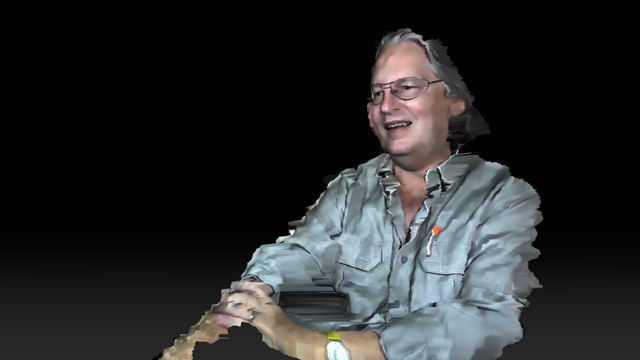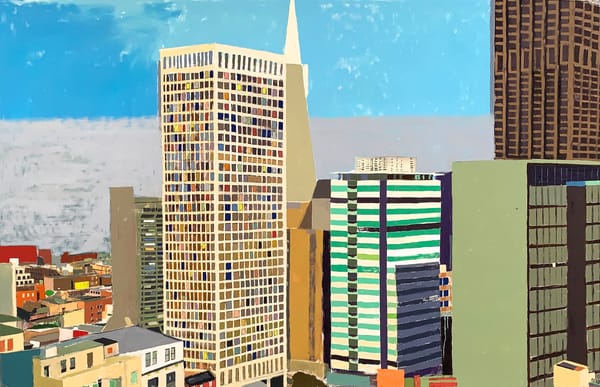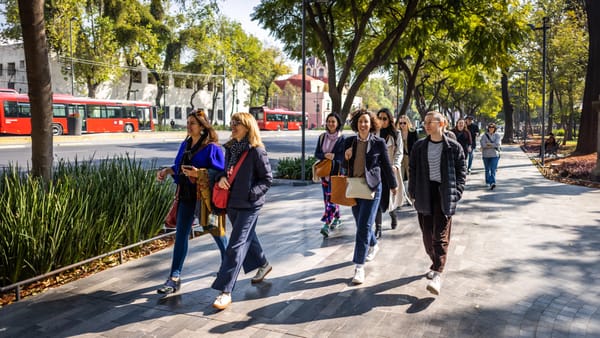The Art Documentary of the Future
Bruce Sterling might be the most influential art writer you've never heard of. The sci-fi novelist and cultural commentator is extremely active in the world of new media and creative coding, writing about artists who work with technology as a medium. A new video interview, part of artist James Georg

Bruce Sterling might be the most influential art writer you’ve never heard of. The sci-fi novelist and cultural commentator is extremely active in the world of new media and creative coding, writing about artists who work with technology as a medium. A new video interview, part of artist James George and documentarian Jonathan Minard’s CLOUDS documentary, shows Sterling explaining why he’s so passionate about code-based work.
The video is shot in RGBD, a new visual format pioneered by George that mingles regular camera footage with infrared, depth-based data from a Microsoft Kinect camera, the same device that helps video gamers control games with their bodies instead of controllers. The depth data from the Kinect allow George and Minard to manipulate how their footage looks at will even after the shoot — they can simulate what the scene would look like shot from any angle, at any distance.
The data points swirl and coalesce to form faces and human forms, or break apart to visualize what Sterling describes as the urban landscape of code. He decries the standard visual cliches of new media art, but still concludes, “writing art-code is an intellectual adventure.” Watch the full video below.
Below, Hyperallergic emailed with CLOUDS creators James George and Jonathan Minard about their project, which ends its Kickstarter campaign next week, and asked them about their goals of turning the footage into an immersive, educational, interactive experience that documents a particular moment in artistic culture.
* * *
Kyle Chayka: How did the idea for the CLOUDS documentary come about?
James George & Jonathan Minard: The first series of experiments took place at the Art&Code conference hosted by the STUDIO for Creative Inquiry at CMU in Pittsburgh, where we first met. The conference had invited many of the creative coding community who had been making experiments with Kinect to a one week intensive residency. Jonathan, who at the time was a Fellow at the STUDIO, had wanted to create interviews with the residents using the Kinect. James, who was one of the residents, had come with the intention of beginning an open source platform for filmmaking with the Kinect that involved combining it with an external camera. CLOUDS began there as a series of interviews with software artists at the conference. The software developed into what is now the RGBDToolkit.
We originally intended to make CLOUDS as a non-interactive documentary rendered in RGBD, extending the approach you can see in our beta version. The fact that we were already visualizing this data in a virtual environment resembling a videogame, with unlimited possible camera positions and visual styles, had opened up our thinking. Then at some point earlier this year, at EyeO Festival, it dawned on us that the conversation we were recording had begun to resemble an interconnected network. CLOUDS is a story featuring a community of artists who collaborate on the internet and share code, and we wanted to represent this in some way. We believe form should reflect content on all levels, so it was not long before we committed to produce this as a non-linear, generative documentary.
KC: Your footage has a very particular aesthetic to it. Describe what kind of technological and artistic innovations we’re seeing with CLOUDS.
JG & JM: RGBD is a format for capturing and visualizing photographic voxel data (color in X,Y,Z) — which are essentially pixels in 3D space. This data format has a unique malleability for visual re-interpretation, and real-time interaction. We increasingly see filmmakers using different kinds of sensors and machine vision techniques for bringing real-world data into virtual environments where live action and CGI merge. As advanced graphics processing becomes fast enough to render these worlds in real-time, it is possible to let viewers navigate these lucid cinematic environments, and become more immersed in a narrative experience.
KC: How did you select the interview subjects for the film? Were there any who were particularly challenging?
JG & JM: The documentary focused on the tightly knit social network of artists surrounding the open-source creative coding platforms like Processing, openFrameworks, and Cinder. These artists, through the process of making their own work and expressing their vision, are simultaneously deeply committed to sharing their process and tools with the community. The documentary selection process was to follow this connective tissue, the creative network that binds the artists together, from one to the next. In the interest of broadening the dialog, we also approached curators like Lindsay Howard and Paola Antonelli and critics and authors such as Bruce Sterling and Regine DeBatty to discuss the way they see this community’s work affecting culture at large.
Being such an international and globally distributed digital community, finding moments to capture our interviews were rare. We were very fortunate to be welcomed by new media festivals such as Resonate and EyeO where many of these artists gather in person to connect and inspire one another. The majority of the interviews were captured during these festivals.
KC: What are your goals for CLOUDS in the future?
JG & JM: We want to complete our vision of an interactive documentary, an application that allows viewers to traverse the conversation database freely following their interests. We see the project as an archive, a snapshot of the community circa 2012 represented in a format true to the times. We’d like to present the archive in a few other ways, we are considering the possibility of creating a web based viewer featuring video snippets, as well as a book featuring high resolution rendered portraits and interview transcripts. It’s important for these voices to be available for future artists and researchers to reference.
KC: What are your predictions for technology and digital culture in 2013?
JG & JM: William Gibson is widely quoted saying “the future is here it’s just not very well distributed yet.” In the last months we’ve just begun to see DIY drones (ARDrone), household 3D printing (MakerBot, Form1), and spatial reconstruction (ReconstructMe) capture the public imagination. The implications of these processes are not yet well understood. In 2013 artists and technologists will be hard at work creating projects that reveal the aesthetic, creative, and social possibilities of these emergences, separating the hype from the reality.
CLOUDS‘s Kickstarter fundraiser ends on Tuesday, January 8.




